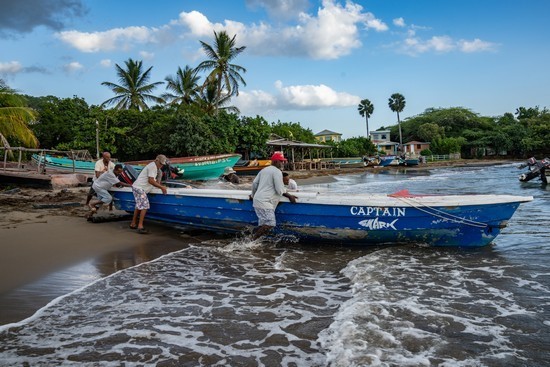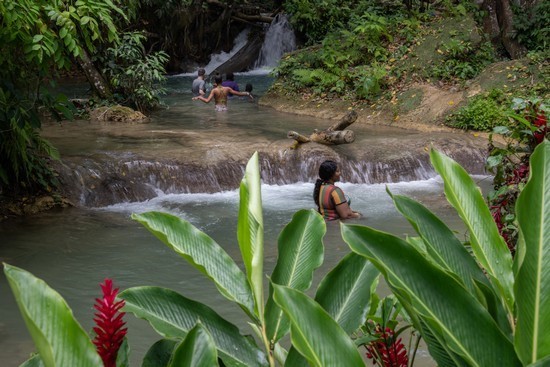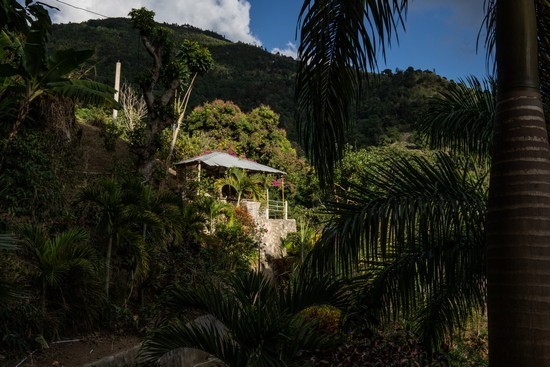“So,” said the tour guide, midway through our trip to
Jamaica. “What are you really looking for?”
It was a good question. In most of the places we went, our
group of four women had been welcomed, warned, and flirted with. But, we were
rarely asked many questions about the nature of our trip. We had flown in from
England and the US in mid-November, just before high season, intending to see
the country over the course of a month, while staying in and visiting as many
locally owned businesses and guesthouses as we could.
اضافة اعلان
Traveling from the east of the lush island to the west, and
mostly avoiding the tourist hot spots of Ocho Rios, Montego Bay, and Negril, we
sought out places that were the opposite of what Jamaica, and many Caribbean
islands, have become known for: resort-style luxury that does not always offer
locals a significant slice of the tourism pie. As a granddaughter of Jamaican
immigrants, the search had special resonance for me.
“When people come to the Caribbean, they’re being funneled
into this journey of the airport to the resort, and that’s all they see of the
country,” said Riaz Philips, author of the award-winning cookbook “West Winds:
Recipes, History, and Tales from Jamaica.” “Usually, if you follow the money
trail of that passage, it doesn’t lead to any tangible benefits for the people
who live and work in those countries.”
 Fishermen at Treasure Beach, a haven of community tourism
where visitors can get out from behind the resort walls, in Jamaica.
Fishermen at Treasure Beach, a haven of community tourism
where visitors can get out from behind the resort walls, in Jamaica.
Nicole Dennis-Benn, who wrote about the dark side of
Jamaican tourism in her debut novel, “Here Comes the Sun”, explained that it
can be hard for Jamaicans to start successful businesses. “It’s really
impossible if you don’t come from wealth already. You’re not going to find much
ownership among the Jamaican working class,” she said.
Even many of the white-sand beaches that foreign visitors
enjoy are off-limits to residents, and are instead controlled by hotels and
resorts, which limit access to their guests. Of the island’s approximately
793km of coastline, less than 5km are designated as public beaches, and about
half of those are used in association with hotels, according to a recent
government policy paper. The public beaches that do exist are often rundown and
not fit for use. That exclusion is emblematic of what some locals feel is the
continuing legacy of colonialism and the history of slavery on the island.
“What we’re offering in the tourism sector is our heritage, our ancestral inheritance.”
Committed to discovering the country that few visitors see,
we set out to find out if it was possible to be good tourists and travel to
Jamaica beyond the resorts.
To the Blue MountainsOur trip began with a long journey from Montego Bay’s
Sangster International Airport to Kingston on the Knutsford Express and then a
taxi up and across the Blue Mountains, high above the capital, to stay at the
BlueMountView guesthouse.
It was at BlueMountView that we met Noel Lindo and his wife,
Michelle. The self-described “King of the Mountain”, Lindo was born in the
area. After living in London for most of his adult life, he and Michelle
decided to return to Jamaica to live in 2011 — building their own house, and
then the guesthouses.
Lindo is fatherly, frank and incredibly chatty. He likes to
layer stories upon stories, taking us from the streets of 1970s London to
colonial Jamaica and back again.
“There’s so much to do in this mountain. It’s unbelievable,”
he said enthusiastically, pointing out hiking trails in the Blue and John Crow
Mountains National Park, hidden waterfalls, and coffee plantations, many of
them owned by locals. Although it is isolated, we discovered that BlueMountView
is within hiking distance of Strawberry Hill, the famous hotel started by the
Island Records founder, Chris Blackwell. We stopped at Eits Cafe, where we
gorged on tender saltfish fritters, warming pumpkin ginger soup, and sticky,
delicious, caramelized-plantain crepes while looking out across the misty
mountains, surrounded by the buzz of swallowtail hummingbirds.
 Benta River Falls, a
locally owned attraction with cascading waterfalls and deep pools for swimming,
in the interior of most western Jamaica.
Benta River Falls, a
locally owned attraction with cascading waterfalls and deep pools for swimming,
in the interior of most western Jamaica.
It was through Lindo that we wound up taking a day trip to
visit the parish of Portland, on the island’s northeast coast. Although perhaps
predominantly known for its beaches and as the location of the Blue Lagoon,
made famous in the 1980 movie, we had a more rural experience. Our first stop
was the Living Daylights, an eco-farm, restaurant, and bar in the jungle of
Bonnie View Hill, Port Antonio, that has been open since 2018, aiming to offer
guests “a piece of paradise”, with a focus on sustainability.
Our second stop in Portland was the self-governing Maroon
community of Charles Town in Buff Bay Valley, whose residents are descendants
of proud Africans who escaped enslavement by fleeing to mountainous regions. It
was one of the few times in Jamaica where we were viscerally reminded of the
island’s dark history and its continuing legacy.
A tour of the small museum charted the history of the
Maroons and how they have protected their freedom and culture over centuries,
creating their own communities and belief systems while fighting against
British slave owners and colonialists in a series of wars. Marcia Douglas, the
current leader of the community (and the first woman to hold the position),
held up a heavy shackle that would have once been clasped around an enslaved
person’s neck. Later, other members of the community brought out drums and
sang. We were taught dances that bind the present and the past.
“We know that tourism is our number one revenue. And a lot of the time when people are living in a prime area, especially working class Jamaicans, they tend to displace them.”
“What we’re offering in the tourism sector is our heritage,
our ancestral inheritance,” Douglas told me after the tour.
Treasure Beach and community tourismAnother long, bumpy drive took us from the Blue Mountains
down to Treasure Beach, a village in the southwest parish of St. Elizabeth. It
is probably the area in Jamaica best known for community tourism — low-impact
travel that works in relative sync with the locals. Once a fishing village,
over the past 30 years, Treasure Beach has become a beacon for tourists looking
to travel off the beaten track.
We spent the bulk of our time in Treasure Beach, sampling
locally owned highlights like Smurfs Café for the best Jamaican breakfast in
town; Eggy’s Beach Bar for the coldest Red Stripes right on the sand; and Gee
Wiz for tasty, reasonably priced vegan food in an eclectic setting — the
restaurant is painted in fading, cotton candy colors and flanked with statues
of long-beaked fish, while the huge, pillared dining room boasts colorful
murals.
Floyd’s Pelican Bar, built from driftwood and palm fronds on
a sandbank in the middle of the ocean, has to be the area’s best-known spot.
Constructed in 2001 by Floyde Forbes, it is a slick operation these days,
requiring a boat journey that costs $40 per person at a minimum from Treasure
Beach. But the vibes, a mile away from shore, are sun-drenched and
otherworldly. The freshly caught fried escovitch fish and bammy (a type of
cassava flatbread) were the best I had on the island.
Treasure Beach is still an anomaly in Jamaica’s tourism
sector.
“There’s no question that over 90 percent of Jamaica’s
traditional room stock is all-inclusive,” said Jason Henzell, chair and
co-owner of Jakes Hotel, the largest business in the area, who also runs a
nonprofit to support locals. “I sat on the board of the Jamaican Ministry of
Tourism for eight years, and I know they had been quite hesitant about
community tourism. Not necessarily in Treasure Beach, but overall, because they
were worried about crime. That’s the cold, hard truth.”
The Ministry of Tourism did not respond to requests for
comment.
 The BlueMountainView guesthouse, which sits on the edge of a
crevasse, with views out over lush greenery, northeast of Kingston, Jamaica, in
the Blue Mountains.
The BlueMountainView guesthouse, which sits on the edge of a
crevasse, with views out over lush greenery, northeast of Kingston, Jamaica, in
the Blue Mountains.
But then, he said, Airbnb changed everything. “It happened
in spite of the ministry not wanting it. It’s almost as though Airbnb was made
for Jamaica, right? Because, you know, every Jamaican is a character.”
The other reality of Treasure Beach, though, is that much of
the beachfront land has been bought up by non-Jamaicans. Henzell, who has
helped landowners sell property in the area, tells me that land these days goes
for over $1 million an acre, putting it out of reach of most locals.
“We know that tourism is our number one revenue. And a lot
of the time when people are living in a prime area, especially working class
Jamaicans, they tend to displace them,” said Dennis-Benn, whose upcoming novel
will explore land ownership.
Last stop: Mel’sOur last stop, two hours from Treasure Beach, was Mel’s
Botanical Retreat, situated on Cave Mountain, in Westmoreland, the westernmost
parish of Jamaica. The retreat, featuring three handbuilt wooden cabins and a
communal kitchen, is high above the shimmering Caribbean Sea and nestled in the
lush jungle. At present, it is being run by a teenage girl named Kiara Clayton.
She is motherless and grieving, but trying to do something very special:
keeping a dream of Black-woman-owned community tourism alive.
With towels spread out under a tree, we sipped strong rum cocktails and played with local children in the water. We were guests, but we were accepted.
Kiara’s mother, Melessia Rodney, founded the retreat, built
on the site of her family’s longtime goat pasture. In the summer of 2021, she
was pregnant with her second child and had recently married the love of her
life. But then, in August, she died: At age 36, COVID took her and her unborn
baby.
Five months later, 15-year-old Kiara decided to take over
the business; balancing it alongside schoolwork and her ambitions to study to
become a lawyer or an entrepreneur in America. Despite her age, she understands
the power of legacy. With the help of her family and her mother’s many friends
from all over the world, she is continuing to host guests at the retreat.
 Plantains, jackfruit,
bird peppers, and other farm-to-table local staples and vegan fare at the
Living Daylights restaurant and bar in the jungle of Bonnie View Hill, Port
Antonio, Jamaica.
Plantains, jackfruit,
bird peppers, and other farm-to-table local staples and vegan fare at the
Living Daylights restaurant and bar in the jungle of Bonnie View Hill, Port
Antonio, Jamaica.
One night, Kiara joined me in the communal kitchen to talk
about the business and why she decided to carry it on. “She wanted it to be
this Black Jamaican woman-owned business. She just loved being strong and
independent,” she said.
What makes the property special among the thousands of
Airbnbs across Jamaica is its commitment to these ideals. “It’s really rare, in
Jamaica, to have a woman born in poverty, and become as successful as Mel
became with her goat pasture,” said Stacey Davis, a family friend who helped
Mel in the early days of the retreat. “Every flower in that retreat, everything
you see, she did by hand.”
At Benta River Falls, an hour or so’s drive away from Mel’s,
we were treated to a joyous day at a series of cascading waterfalls and deep
pools, led by two energetic guides. The property’s owner, Stacy Wilson, played
dominoes with a bunch of men in the small bar next to the falls, while we ate a
delicious plate of crispy fries, and giggled with the pink-haired bartender.
Wilson’s American cousin, Jahcobee Faith, explained that the family has owned
the area since the 1970s, but only set up business in 2017, charging, at the
time we visited, $20 for tourists and a nominal 500 Jamaican dollars, or about
$3.25, for locals.
Closer to Mel’s, Bluefields beach provided all the white
sand and azure, temperate water you could wish for, along with the knowledge
that it is one of the few beaches on the island that explicitly remains open
for locals. It is looked after by the Bluefields People’s Community
Association, which promotes sustainable social and economic development. With
towels spread out under a tree, we sipped strong rum cocktails and played with
local children in the water. We were guests, but we were accepted.
The reality is that Jamaica beyond the resorts is beautiful
but impoverished, and still visibly recovering from the pandemic. It can get
expensive if you do not drive and need to rely on taxis to get around, though
route taxis, as used by locals, can offset some costs. The country has a Level
3 warning from the US State Department, with some regions listed as Level 4, Do
Not Travel, but these were not on our itinerary. Traveling around the country
felt completely safe in a group; just keep your wits about you, and remain
polite.
Read more Travel
Jordan News







